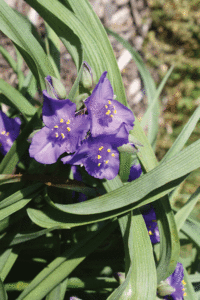
Spider lilies’ tiny bright blue-purple flowers open up in the early morning and last only one day. but there are so very many flowers that is seems to be in continuous blooms from May through the end of July. (Photo by Ginny Rosenkranz)
The spider lily, or tradescantia virginiana or Virginia spiderwort, is a native herbaceous perennial that thrives in almost any sunny or lightly shady garden.
The tiny bright blue-purple flowers open up in the early morning and last only one day, but there are so many flowers that the plant seems to be in continuous blooms from May through the end of July.
The flowers have three petals with bright yellow stamens and are arranged in clusters on the ends of the stems, keeping the flowers above the foliage. The plants form a dense clump of arching leaves and stems about 1 1/2 to 3 feet tall.
The sap in the stems, when cut, becomes threadlike and silky, looking a bit like a spiders web.
When in flower, the various pollinators including many butterflies and native bees.
There are a few cultivars for this lovely native plant, including “Concord Grape” with deep purple flowers, “Bilberry Ice,” that has pure white petals with center steaks of purple, “Sylvana,” with raspberry colored flowers and “Innocence,” with pure white flowers.
The plants seem to tire after all that blooming, so it is a good idea to trim back the plant in August so the new foliage can help regenerate the plants.
The spiderwort will often bloom in the fall if trimmed back.
Plants like to grow in moist, but well drained, soils and are very tolerant of all soils on the Eastern Shore.
Flowers can also be indicators of when certain insects begin to emerge, and research has shown that when the Virginia Spiderwort is in bloom, the Bagworms start to hatch out.
(Editor’s Note: Ginny Rosenkranz is a commercial horticulture specialist with the University of Maryland Extension.)



